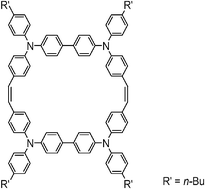New semiconductors based on triphenylamine with macrocyclic architecture: synthesis, properties and applications in OFETs†
Abstract
Two novel macrocycles based on triphenylamine (TPA) have been synthesized by McMurry coupling reactions. The cyclic compound 2 consisted of two triphenylamines linked with


 Please wait while we load your content...
Please wait while we load your content...